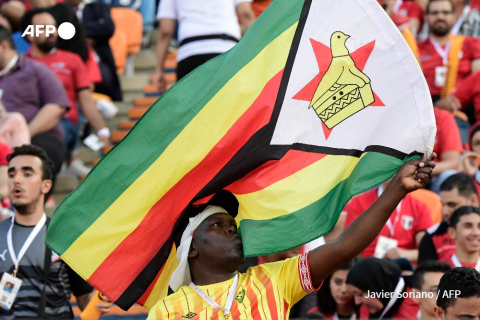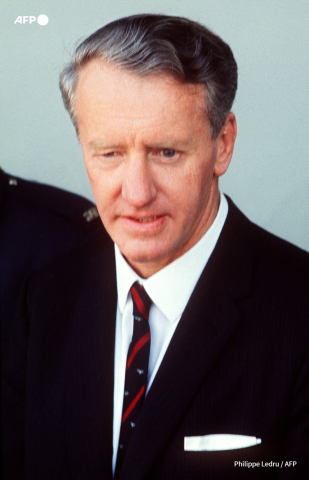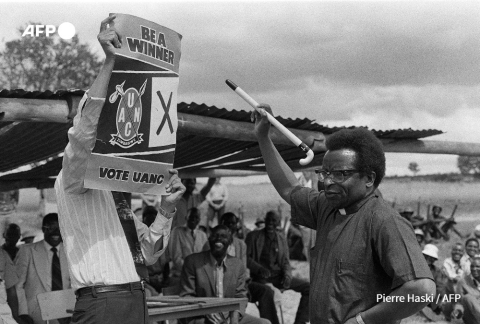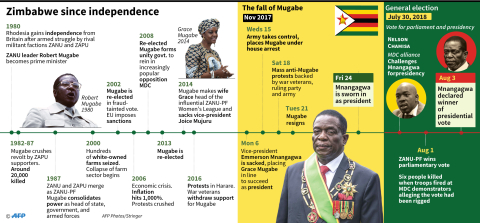In 1980, Zimbabwe is born

Zimbabwe was founded on April 18, 1980, emerging from 90 years as a British colony including 15 years as the rebel breakaway country of Rhodesia.
Its founding brought to an end a seven-year Bush War that claimed around 27,000 lives and sowed the seeds of a political rivalry that would endure.
Here is a broad overview of events leading up to independence, drawn up by AFP journalist Florence de Marignan for the 10th anniversary.
PARIS, April 12, 1990 (AFP) - The Union Jack is slowly lowered. An enormous clamour rises from across Salisbury's Rufaro stadium, reaching fever pitch as 36,000 people celebrate the hoisting of the new green-gold-red-black-white flag, marked with a star and a Zimbabwe bird, symbols of the new state.
The crowd roars to a 21-gun salute. The din of planes fills the night sky. The applause and cries of joy gradually subside and the singing starts.
It is shortly after midnight on Friday, April 18, 1980. Zimbabwe has just been born.
- A new start -
Ninety years of colonisation has been brought to an end with Britain's granting of independence to its former rebel colony.
In front of the excited crowd, the heir to the British throne, Prince Charles, hands the text of the constitution to the president of the new state, Canaan Banana, in a symbolic transfer of power.
The last link between London and Salisbury has been buried.
Rarely have so many dignitaries turned out for the birth of an African state.
There are 100 foreign delegations in the official stands, the handpicked guests reflecting the foreign policy leanings of the new leaders.
Apartheid South Africa and most of the countries of communist Eastern Europe are not represented.
However the continent's main liberation movements -- including those of South Africa, the Polisario Front of the Western Sahara, and the Palestine Liberation Organisation -- are in attendance, alongside Western countries.
Notably absent is the former leader of rebel Rhodesia, Ian Smith.
- A rebel colony -

Smith had on November 11, 1965 also declared independence, but unilaterally and against the wishes of London.
It was the first time a British Crown colony had broken away since the United States in July 1776.
His Unilateral Declaration of Independence (UDI) led to a 15-year dispute with London during which black nationalists launched a guerrilla war against the white regime in Salisbury, today's Harare.
Smith made the bold move to put an end to long independence negotiations with Britain and to prevent blacks -- who numbered six million against the white population of 250,000 -- from coming to power.
Previously the colony of Southern Rhodesia, the rebel country took the name Rhodesia, after British explorer Cecil Rhodes who claimed the region on behalf of the Crown in the late 19th century.
It was immediately condemned by African and foreign states.
Internationally isolated and under British and UN sanctions, Smith's regime soon only had links with South Africa and Portugal and its colonies.
London believed it would eventually cave in under the pressure. But it underestimated the determination of Rhodesia's whites who benefited from an abundant reserve of black manpower to build a self-sufficient and prosperous nation.
- Guerrilla war -
From the mid-1960s black guerrillas entered Rhodesia from Zambia, setting up training camps and mobilising the black population.
But they were easily overcome by the government forces and left in disarray.
In 1971 a reorganisation of the guerrilla movements heralded a new and decisive phase in the conflict.
The first act came at dawn on December 21, 1972 when a small commando launched a rocket attack on a white-owned farm in the northeastern locality of Centenary.
A girl was wounded and windows broken, and the white community saw it as a one-off incident.
It turned out to be the start of seven years of conflict called the Bush War, with the guerrilla force strengthening year to year and clashes intensifying.
When neighbouring Mozambique obtained independence in 1975, its 1,100-kilometre border became a new entry point for fighters and supplies.
However the black movement was divided, with rivalry developing between the ZAPU (Zimbabwe African People's Union) faction led by Joshua Nkomo and Robert Mugabe's ZANU (Zimbabwe African National Union).
While both followed a socialist ideology, the more moderate ZAPU wanted negotiations with the authorities for a transfer of power.
ZANU was more radical, favouring armed struggle.
A third player was the United African National Council of Methodist Bishop Abel Muzorewa, which rejected violence while demanding "one man, one vote".
Amid the infighting, Mugabe emerged by 1976 as the leader of the overall 12,000-strong guerrilla movement.

- Minority rule ends -
Under pressure from the escalating war and waning support from Portugal and South Africa, Smith opened negotiations on a transfer of power.
The white regime met with black nationalists for a first time on August 25, 1975 in a train on a bridge over Victoria Falls bordering Zambia after demands for a venue on neutral territory.
While that first meeting failed, it launched a process that culminated in a 1978 agreement on a political transition.
In April 1979 elections were held for the 100-seat parliament with a majority of seats allotted to blacks, but some still guaranteed for whites.
Muzorewa's party won and he became prime minister of the state of Zimbabwe-Rhodesia, proclaimed in June 1979.
White minority rule had ended.
- Settlement -
But the guerrillas did not halt their insurgency and the new nation was also rejected on the world stage.
Britain called Muzowera and nationalist leaders including Mugabe and Nkomo to talks starting in September 1979 on reaching internationally recognised independence.
On December 21 the parties signed the Lancaster House Agreement, named for the venue of the talks, committing to an immediate ceasefire and new elections in 1980.
Those elections were won by Mugabe, who was prime minister and then president.
He first won praise for his policy of reconciliation but went on to set up an authoritarian regime which brutally repressed opponents and implemented a land reform programme that resulted in economic collapse.
Forced to resign in 2017, aged 93 and after 37 years in power, Mugabe died two years later in Singapore.
Here a timeline of his 37 years in power.
- From Rhodesia to Zimbabwe -

- April 18, 1980 : Rhodesia gains independence, taking the new name Zimbabwe. The 1972-1979 war of independence between nationalist blacks and the minority white regime led by Ian Smith has left 27,000 dead.
Mugabe, head of ZANU, takes power as prime minister. ZAPU leader Joshua Nkomo, Mugabe's partner in the armed struggle, becomes interior minister.
- February 1982 : Nkomo, accused of plotting a coup, is dismissed. Armed resistance in his stronghold of Matabeleland is met with bloody government repression. At least 20,000 people die.
- December 1987 : Mugabe becomes head of state after reforming the constitution to usher in a presidential regime. Two years later rival movements merge to become the Zimbabwe African National Union-Patriotic Front (ZANU-PF).
- White farms seized -
- February 2000 : Squatters and pro-Mugabe war veterans start a violent campaign of seizure of white farms.
More than 4,000 of the 4,500 white farmers are stripped of their land with the support of the regime, with the officially stated goal to correct colonial-era inequalities.
- Mugabe hangs on -
- March 2002 : Mugabe is re-elected president in a poll marred by violence and widely denounced as rigged. Western sanctions are imposed.
- March 2008 : ZANU-PF is defeated by Morgan Tsvangirai's Movement for Democratic Change (MDC) in parliamentary polls. Tsvangirai wins the first-round presidential vote but withdraws from the second round, citing violence against his supporters. Mugabe is inaugurated for a new term.
- August 2013 : Mugabe is declared re-elected in July 31 elections with 61 percent of the vote, against Tsvangirai's 34 percent.
Tsvangirai describes the election as a "huge farce" and "null and void". The EU, however, starts normalising relations with Zimbabwe, lifting most of its sanctions.

- Purge -
- December 2014 : Mugabe names his 49-year-old wife Grace as head of the ruling ZANU-PF party's women's wing. He seeks to quell infighting over his successor by purging his foes.
- April 2016 : The MDC gathers more than 2,000 demonstrators in Harare in the biggest march organised for a decade against Mugabe.
- November 2017 : Mugabe fires Vice President Emmerson Mnangagwa, long considered his probable successor, who has close ties to the military and the powerful independence war veterans. Mnangagwa flees the country.
- Army takes charge -
- November 13, 2017 : Army chief General Constantino Chiwenga demands a "stop" to purges and warns the military could intervene.
- November 14-15, 2017 : Tanks take up position in Harare. Mugabe is placed under house arrest with his family.
- November 19, 2017 : The ZANU-PF party sacks Mugabe as its leader.
- November 21, 2017 : Mugabe resigns as head of state. Three days later Mnangagwa is sworn in as his successor, promising to fight corruption and reduce poverty.Obituary of Zimbabwe's father of independence Robert Mugabe - Antoine Demaison/James Wilson/Jeremy Martin -
